|
|

Our routing software includes the following media translation features which enable network communications across heterogeneous media:
This chapter describes the tasks you must perform to configure your router for IBM network media translation. For a complete description of the commands in this chapter, refer to the "IBM Network Media Translation Commands" chapter in the Router Products Command Reference publication.
SDLLC is a Cisco Systems proprietary software feature that enables a device on a Token Ring to communicate with a device on a serial link by translating between Logical Link Control, Type 2 (LLC2) and Synchronous Data Link Control (SDLC) at the link layer.
Systems Network Architecture (SNA) uses SDLC and LLC2 as link-layer protocols to provide a reliable connection. The translation function between these industry-standard protocols takes place in the proprietary Cisco software.
Figure 29-1 illustrates how SDLLC provides data link layer support for SNA communication.
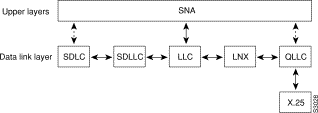
The SDLLC software allows a physical unit (PU) 4, PU 2.1, or PU 2 to communicate with a PU 2 SDLC device as follows:
In all of these topologies, each IBM end node (the FEP and cluster controller) has no indication that its counterpart is connected to a different medium running a different protocol. The 37x5 FEP responds as if the 3x74 cluster controller were communicating over a Token Ring, whereas the 3x74 responds as though the 37x5 FEP were communicating over a serial line. That is, the SDLLC software provides translation between the two media to be transparent to the end nodes.
Central to Cisco's SDLLC feature is the concept of a virtual Token Ring device residing on a virtual Token Ring. Because the Token Ring device expects the node with which it is communicating also to be on a Token Ring, each SDLLC device on a serial line must be assigned an SDLLC virtual token ring address (SDLLC VTRA). Like real Token Ring addresses, SDLLC VTRAs must be unique across the network.
In addition to the SDLLC VTRA, an SDLLC virtual ring number (SDLLC VRN) also must be assigned to each SDLLC device on a serial line. (The SDLLC VRN differs from the virtual ring group numbers that are used to configure RSRB and multiport bridging.)
As part of its Virtual Telecommunications Access Method (VTAM) configuration, the IBM node on the Token Ring has knowledge of the SDLLC VTRA of the serial device with which it communicates. The SDLC VTRA and the SDLLC VRN are a part of the SDLLC configuration for the router's serial interface. When the Token Ring host sends out explorer packets with the SDLLC VTRA as the destination address in the Media Access Control (MAC) headers, the router configured with that SDLLC VTRA intercepts the frame, fills in the SDLLC VRNA and the bridge number in the routing information field (RIF), and then sends the response back to the Token Ring host. A route is then established between the Token Ring host and the router. After the router performs the appropriate frame conversion, it uses this route to forward frames to this serial device.
IBM nodes on Token Ring media normally use frame sizes greater than 1 KB, whereas the IBM nodes on serial lines normally limit frame sizes to 265 or 521 bytes. To reduce traffic on backbone networks and provide better performance, Token Ring nodes should send as large frames as possible. As part of the SDLLC configuration on the router's serial interface, the largest frame size the two media will support should be selected. The router can fragment the frames it receives from the Token Ring device before forwarding them to the SDLC device; however, it does not assemble the frames it receives from the serial device before forwarding them to the Token Ring device.
SDLLC maintains a dynamic RIF cache. SDLLC caches the entire RIF; that is, the RIF from the source station to destination station. The cached entry is based on the best path at the time the session began. SDLLC uses the RIF cache to maintain the LLC2 session between the router and the host FEP. SDLLC does not age these RIF entries. Instead, SDLLC places an entry in the RIF cache for a session when the session begins and flushes the cache when the session terminates. You cannot flush these RIFs because if you flushed the RIF entries randomly, the router would not be able to maintain the LLC2 session to the host FEP.
You can perform the tasks in the following sections to configure SDLLC:
See the end of this chapter for SDLLC configuration examples.
In the SDLLC configuration with direct connection, a 37x5 FEP on a Token Ring and a 3x74 cluster controller connected to a serial line are each connected to an interface on the same router configured with SDLLC. In this configuration, the LLC2 session extends from the 37x5 FEP across the Token Ring to the router. The SDLLC session extends from the router across the serial line to the 3x74 cluster controller. The SNA session extends across the Token Ring and the serial line to provide an end-to-end connection. The router is configured with source-route bridging (SRB).
To configure SDLLC with direct connection, you must perform the tasks in the following sections:
For an example of how to configure SDLLC with direct connection, see the "Example of SDLLC with Direct Connection" later in this chapter.
The interfaces you will configure for SDLLC media translation are the serial interfaces that connect to the serial lines linking the remote SDLC devices. To configure them, perform the following task in interface configuration mode:
| Task | Command |
|---|---|
Enable SDLLC media translation on a serial interface. | sdllc traddr xxxx.xxxx.xx00 lr bn tr |
You can associate a SAP value by performing the following task in interface configuration mode:
| Task | Command |
|---|---|
Associate a SAP value. | sdllc sap sdlc-address ssap dsap |
The exchange of identification (XID) value you define on the router must match that of the IDBLK and IDNUM system generation parameters defined in VTAM of the Token Ring host to which the SDLC device will be communicating. To define XID on the router, perform the following task in interface configuration mode:
| Task | Command |
|---|---|
Specify the XID value appropriate for the SDLC station to match VTAM values. | sdllc xid address xxxxxxxx |
The Token Ring host is always kept in a state ready to accept a connection from the remote serial device. The remote serial device is responsible for initiating connections. The advantage of this scheme is that the serial device can communicate with the Token Ring host whenever it chooses without requiring personnel to be on the host site.
The router actually initiates the connection on behalf of the serial device. To initiate connections, both the MAC address of the Token Ring host and the SDLC line address are required. You must configure the router to define the Token Ring host as the partner of the serial device. To do so, perform the following task in interface configuration mode:
| Task | Command |
|---|---|
Enable connections for SDLLC. | sdllc partner mac-address sdlc-address |
A router need not directly connect the two IBM end nodes: a 37x5 FEP on a Token Ring and a 3x74 cluster controller connected to a serial line can be connected to different routers. However, the router to which the 3x74 is connected must be configured with SDLLC. The routers communicate via RSRB using direct encapsulation, RSRB over an FST connection, or RSRB over a TCP connection. RSRB transports packets between Router A and Router B, while Router B performs all conversion between the LLC2 and SDLC protocols by means of the SDLLC software.
To configure the router for SDLLC with RSRB you must perform all the tasks in the "Configure SDLLC with Direct Connection" section earlier in this chapter. In addition, you must perform one of the sets of tasks in the following sections:
For more information about configuring RSRB, see the chapter "Configuring Source-Route Bridging" in this manual and "Source-Route Bridging Commands" in the Router Products Command Reference publication.
For an example of how to configure SDLLC with RSRB, see the section "Example of SDLLC with RSRB (Multiple 3x74s)" later in this chapter.
To configure SDLLC with RSRB using direct encapsulation, perform the following tasks in global configuration mode:
| Task | Command |
|---|---|
Define a ring group. | |
Define a remote peer. | source-bridge remote-peer ring-group interface interface-name [mac-address] |
To configure SDLLC with RSRB over an FST connection, perform the following tasks in global configuration mode:
| Task | Command |
|---|---|
Define a ring group. | |
For FST connection only, set up an FST peer name. | source-bridge fst-peername local-interface-address |
Define a remote peer. |
To configure SDLLC with RSRB over a TCP connection, perform the following tasks in global configuration mode:
| Task | Command |
|---|---|
Define a ring group. | source-bridge ring-group ring-group |
Define a remote peer. | source-bridge remote-peer ring-group tcp |
RSRB can be configured for only local acknowledgment with RSRB using IP encapsulation over a TCP connection. Configuring SDLLC local acknowledgment can reduce time-outs and keepalive traffic on the connection.
If LLC2 local acknowledgment is configured, it must be configured on the serial interface of the router on the 3x74 cluster controller side of the connection and on the Token Ring interface of the router on the 37x5 FEP side of the connection. Whether or not local acknowledgment is configured, the SNA session extends end-to-end and the SDLC session extends from the router configured with the serial interface to the 3x74 cluster controller. However, the LLC2 session extends from the 37x5 FEP to the router with the Token Ring interface configured. The LLC2 session is locally terminated at that router. A TCP session is then established across the wide-area network (WAN) to router on the 3x74 side of the connection.
To configure the router for SDLLC with RSRB and local acknowledgment, you must perform all the tasks in the "Configure SDLLC with Direct Connection" section earlier in this chapter. In addition, you must perform the following tasks in global configuration mode:
| Task | Command |
|---|---|
Define a ring group. | source-bridge ring-group ring-group |
Define a remote peer with the local acknowledgment feature. | source-bridge remote-peer ring-group tcp |
Enable local acknowledgment for connections involving SDLLC media translation. |
Local acknowledgment is not supported when the LLC2 device is attached to an Ethernet rather than to a Token Ring.
For an example of how to configure SDLLC with RSRB and local acknowledgment, see the section "Example of SDLLC with RSRB and Local Acknowledgment" later in this chapter.
For more information about configuring RSRB and local acknowledgment, see the chapter "Configuring Source-Route Bridging" in this manual and "Source-Route Bridging Commands" in the Router Products Command Reference publication.
SDLLC support over Ethernet combines translational bridging with Ethernet support of 37x5 FEP connections. Figure 29-2 shows SDLLC with Ethernet and translational bridging. The 3x75 FEP is attached to Router A through Ethernet. The same router is configured for translational bridging, which translates Ethernet packets into Token Ring packets and passes them across the WAN to Router B connected to the 3x74 cluster controller via a serial line. The LLC2 session terminates at the Router B connected to the 3x74 cluster controller. In addition, Router B maintains an SDLC session from itself to the cluster controller.

To increase performance on connections involving SDLLC media translation, perform the tasks in the following sections:
Note the additional information in the section "Other Customizing Considerations" later in this chapter.
Faster screen updates to 3278-style terminals often result by configuring the Token Ring FEP to send as large an I-frame as possible and then allowing the router to segment the frame into multiple SDLC I-frames.
After the Token Ring FEP has been configured to send the largest possible I-frame, it is best to configure the router to support the same maximum I-frame size. The default is 516 bytes. The maximum value the router can support is 8144 bytes.
To set the largest LLC2 I-frame size, perform the following task in interface configuration mode:
| Task | Command |
|---|---|
Specify the largest I-frame size that can be sent or received by the designated LLC2 primary station. | sdllc ring-largest-frame value |
Generally, the router and the SDLC device with which it communicates should support the same maximum SDLC I-frame size. The larger this value, the better the line is utilized, thus increasing performance.
After the SDLC device has been configured to send the largest possible I-frame, you must configure the router to support the same maximum I-frame size. The default is 265 bytes. The maximum value the router can support must be less than the value of the LLC2 largest frame value defined when setting the largest LLC2 I-frame size.
To set the largest SDLC I-frame size, perform the following task in interface configuration mode:
| Task | Command |
|---|---|
Set the largest I-frame size that can be sent or received by the designated SDLC station. | sdlc sdlc-largest-frame address value |
You can increase the data transfer rate by increasing the SDLC line speed on the serial interface. If possible, increase the link speed of the 3x74 to 19.2 kbps on older units, or to 64 kbps on new units.
To increase the SDLC line speed, perform the following tasks in interface configuration mode:
| Task | Command |
|---|---|
Adjust the clock rate on the serial interface of the SCI and MCI cards to an acceptable bit rate. |
| 1This command is documented in the "Interface Commands" chapter of the Router Products Command Reference publication. |
In addition to adjusting the SDLLC parameters described in this section, you can improve performance on the connection by adjusting the LLC2 and SDLC parameters described in the chapter "Configuring LLC2 and SDLC Parameters."
For IBM host configuration consider changing the default MAXOUT (window size) value. Widely used installation guides for IBM equipment show a MAXOUT value of 1 in the VTAM-switched major node for the 3174 PU. Changing this value to 7 improves the performance, because VTAM can send seven frames before requiring an acknowledgment.
To monitor connections using SDLLC media translation, perform the following monitoring tasks in privileged EXEC mode:
Display information about SDLC and LLC2 connections involving interfaces on which SDLLC media translation has been enabled. Display the current state of any connections using local acknowledgment for LLC2 and SDLLC connections. Display information about LLC2 connections involving interfaces on which SDLLC media translation has been enabled.
Task
Command
1This command is documented in the "LLC2 and SDLC Commands" chapter of the Router Products Command Reference publication.
In show llc2 output, look for the LLC2 connections that correspond to the MAC addresses you assigned to the SDLLC interfaces using the sdllc traddr command. For information about these commands, see the chapter "LLC2 and SDLC Commands" and "IBM Network Media Translation Commands" in the Router Products Command Reference publication.
Qualified Logical Link Control (QLLC) is a data link protocol defined by IBM that allows SNA data to be transported across X.25 networks. (Although IBM has defined other protocols for transporting SNA traffic over an X.25 network, QLLC is the most widely used.) Figure 29-3 illustrates how QLLC conversion provides data link layer support for SNA communication.

As shown in Figure 29-4, any devices in the SNA communication path that use X.25, whether end systems or intermediate systems, require a QLLC implementation.

As shown in Figure 29-5, the QLLC conversion feature eliminates the need to install the X.25 software on local IBM equipment. A device that is locally attached to a Token Ring network can communicate through a router that is running the QLLC Conversion feature with a remote device that is attached to an X.25 network using QLLC. Typically, the locally attached device is a front-end processor (FEP), an AS 400, or a PS/2, and the remote device is a terminal controller or a PS/2. In this case, only the remote device needs an X.25 interface and the FEP can communicate with the terminal controller as if it were directly attached via a Token Ring network.

More elaborate configurations are possible. The router that implements QLLC conversion need not be on the same Token Ring network as the FEP. As shown in Figure 29-6, QLLC/LLC2 conversion is possible even when an intermediate IP WAN exists between the router connected to the X.25 network and the router connected to the Token Ring.

SNA uses QLLC and X.25 as link-layer protocols to provide a reliable connection. QLLC itself processes QLLC control packets. In a Token Ring environment, SNA uses LLC to provide a reliable connection. The LAN-to-X.25 (LNX) software provides a QLLC conversion function to translate between LLC and QLLC.
Figure 29-7 shows the simplest QLLC conversion topology: a single Token Ring device (for example, a 37x5 FEP) communicates with a single remote X.25 device (in this case a 3x74 cluster controller). A router connects the Token Ring network to the X.25 network.
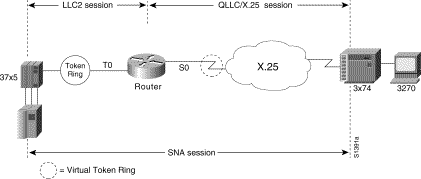
In Figure 29-7, each IBM end node has no indication that its counterpart is connected to a different medium running a different protocol. The 37x5 FEP responds as if the 3x74 cluster controller were communicating over a Token Ring, whereas the 3x74 responds as though the 37x5 FEP were communicating over an X.25 network. This is accomplished by configuring the router's X.25 interface as a virtual Token Ring, so that the X.25 virtual circuit appears to the Token Ring device (and to the router itself) as if it were a Token Ring to which the remote X.25 device is attached.
Also in this figure, the LLC2 connection extends from the 37x5 FEP across the Token Ring network to the router. The QLLC/X.25 session extends from the router across the X.25 network to the 3x74 cluster controller. Only the SNA session extends across the Token Ring and X.25 networks to provide an end-to-end connection from the 37x5 FEP to the 3x74 cluster controller.
As Figure 29-8 shows, a router need not directly connect the two IBM end nodes; instead, some type of backbone WAN can connect them. Here, RSRB transports packets between Router A and Router B, while Router B performs all conversion between the LLC2 and X.25 protocols. Only the router attached to the serial line (Router B) needs to be configured for QLLC conversion. Both Router A and Router B are configured for normal RSRB.
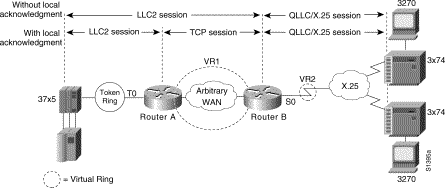
How communication sessions are established over the communication link varies depending on whether or not LLC2 local acknowledgment has been configured on Router A's Token Ring interface. In both cases, the SNA session extends end-to-end and the QLLC/X.25 session extends from Router B to the 3x74 cluster controller. If LLC2 local acknowledgment has not been configured, the LLC2 session extends from the 37x5 FEP across the Token Ring network and the arbitrary WAN to Router B. In contrast, when LLC2 local acknowledgment has been configured, the LLC2 session extends from the 37x5 FEP Router A, where it is locally terminated. A TCP session is then used across the arbitrary WAN to Router B.
Although the procedures you use to configure QLLC are very similar to those used to configure SDLLC, there are structural and philosophical differences between the point-to-point links that SDLC uses and the multiplexed virtual circuits that X.25 uses.
The most significant structural difference between QLLC conversion and SDLLC is the addressing. To allow a device to use LLC2 to transfer data, both SDLLC and QLLC provide virtual MAC addresses. In SDLLC, the actual MAC address is built by combining the defined virtual MAC (whose last byte is 0x00) with the secondary address used on the SDLC link; in this way, SDLLC supports multidrop. In QLLC conversion, multidrop is meaningless, so the virtual MAC address represents just one session and is defined as part of the X.25 configuration. Because one physical X.25 interface can support many simultaneous connections for many different remote devices, you only need one physical link to the X.25 network. The different connections on different virtual circuits all use the same physical link.
The most significant difference between QLLC conversion and SDLLC is the fact that a typical SDLC/SDLLC operation uses a leased line. In SDLC, dial-up connections are possible, but the maximum data rate is limited. In QLLC, both switched virtual circuits (SVCs) and permanent virtual circuits (PVCs) are available, but the favored use is SVC. While the router maintains a permanent connection to the X.25 network, a remote device can use each SVC for some bounded period of time and then relinquish it for use by another device. Using a PVC is very much like using a leased line.
Table 29-1 shows how the QLLC commands correspond to the SDLLC commands.
| QLLC Command | Analogous SDLLC Command |
|---|---|
qllc largest-packet | sdllc ring-largest-frame, sdllc sdlc-largest-frame |
qllc partner | sdllc partner |
qllc sap | sdllc sap |
qllc srb, x25 map qllc, x25 pvc qllc | sdllc traddr |
qllc xid | sdllc xid |
source-bridge qllc-local-ack | source-bridge sdllc-local-ack |
Consider the following when implementing QLLC conversion:
You can configure DLSw+ for QLLC connectivity, which enables both of the following two scenarios:
For information on configuring DLSw+ for QLLC conversion, refer to the "Configuring DLSw+" chapter.
You can configure DSPUs for QLLC. For more information on this configuration, refer to the "Configuring DSPU and SNA Service Point Support" chapter.
Perform the tasks in the following sections to configure QLLC conversion. The first task is required; all others are optional and depend on your specific needs.
See the end of this chapter for QLLC configuration examples.
The interfaces you configure for QLLC conversion are the serial interfaces that connect to the X.25 network linking the remote devices with which you plan to communicate. To enable QLLC conversion, you must perform the first of the following tasks. Perform the remaining tasks as appropriate.
You can enable QLLC conversion on a serial interface to support either a switched virtual circuit (SVC) or a permanent virtual circuit (PVC). The tasks you perform differ somewhat depending on the type of virtual circuit you plan to support on the interface. In either case, first verify that RSRB is enabled by performing the following task in privileged EXEC mode:
| Task | Command |
|---|---|
Ensure that RSRB is enabled on the interfaces. |
| 1This command is documented in the "System Image, Microcode Image, and Configuration File Load Commands" chapter of the Router Products Command Reference publication. |
In the sections for the appropriate serial interfaces of the show configuration display, look for one or more source-bridge remote-peer entries and a source-bridge rn entry. For more information about configuring a serial interface for RSRB, see the chapter "Configuring LLC2 and SDLC Parameters" in this manual.
To enable QLLC conversion to support an SVC, perform the following tasks in interface configuration mode:
| Task | Command |
|---|---|
Step 1 Map a virtual Token Ring MAC address for the interface to its X.121 address. | x25 map qllc virtual-mac-addr x121-addr [x25-map-options] |
Step 2 Enable the use of QLLC conversion on the interface. | qllc srb virtual-mac-addr srn trn |
To enable QLLC conversion to support a PVC, perform the following tasks in interface configuration mode:
| Task | Command |
|---|---|
Step 1 Set up a PVC for QLLC conversion. | x25 pvc circuit qllc x121-address [x25-map-options] |
Step 2 Enable the use of QLLC conversion on the interface. | qllc srb virtual-mac-addr srn trn |
In a Token Ring or RSRB environment the LAN-attached devices initiate a connection by sending a null XID packet upstream. If the router forwards this null XID to an X.25-attached FEP, the FEP responds as if it were connecting to an PU2.1 device, and breaks the connection when the PU 2.0 next sends an XID Format 0 Type 2. To resolve this situation and to enable the connection, perform the following task in interface configuration mode:
| Task | Command |
|---|---|
Enable connection between a PU 2.0 on the LAN side and a FEP running NPSI on the X.25 side. | qllc npsi-poll virtual-mac-addr |
The qllc npsi-poll command intercepts any null XID packet that the router receives on the LAN interface, and returns a null XID response to the downstream device. It continues to allow XID Format 3 and XID Format 0 packets through the X.25 device.
The exchange identification (XID) serves as a password to ensure that only those devices that should communicate with the Token Ring host have that privilege. If the XID is defined in NCP on the host, you must enable the router to reply (on behalf of the X.25 device) to the Token Ring host's requests for an XID reply. Although the XID value is used to reply to XID requests received on the LLC2 side of the connection, you apply this command on the serial interface defined for X.25. This XID value must match that of IDBLK and IDNUM defined in the NCP.
To define the XID value associated with an X.25 device, perform the following task in interface configuration mode:
| Task | Command |
|---|---|
Specify the XID value appropriate for the X.25 device associated with the Token Ring interface. | qllc xid virtual-mac-addr xid |
If you plan to use SVCs rather than PVCs, you must enable the router to open a connection to the local Token Ring device on behalf of the remote X.25 device when an incoming call is received. When QLLC conversion is used over an SVC, the remote X.25 device typically initiates the X.25/QLLC session, and the router in turn initiates the LLC2 session.
To enable the router to open a connection to the local Token Ring device, perform the following task in interface configuration mode:
| Task | Command |
|---|---|
Enable the router to open a connection to the local Token Ring device. | qllc partner virtual-mac-addr mac-addr |
To customize your configuration of QLLC conversion, you can perform one or more of the following tasks:
These tasks are described in the following sections.
Enable local acknowledgment when the round-trip time through the TCP/IP network is as large or larger than the LLC2 timeout period.
To enable QLLC local acknowledgment for RSRB connections, perform the following global configuration task on the router connected to the X.25 interface and configure the remote peers for local acknowledgment:
| Task | Command |
|---|---|
Enable QLLC local acknowledgment for remote source-route-bridged connections. |
If, for example, Router B with X.25 interface has the IP address ip1, and the remote peer (Router A) has the address ip2, and they use a virtual ring group vrg, then both routers use the following configuration commands:
source-bridge ring-group vrg source-bridge remote-peer vrg tcp ip1 local-ack source-bridge remote-peer vrg ip2 local-ack
You only need to enable QLLC local acknowledgment on Router B, as follows:
source-bridge qllc-local-ack.
This will not affect Router A.
To use SAP values other than the default IBM SAP values, perform the following task in interface configuration mode:
| Task | Command |
|---|---|
Specify a SAP value other than the default IBM SAP value. |
There are two ways for a packet to become segmented:
If the QLLC software does not perform SNA segmentation, then the X.25 software must be capable of performing X.25 segmentation of the largest packet that it can receive from the LLC2 side. This packet can be several thousand bytes long and the typical size for X.25 packets is 1024 bytes or less. (The default is 128, but that can be overridden with larger values.) The X.25 software, especially in the X.25 attached IBM end station, might not be able to reassemble a very large packet. In this situation, specifying the largest QLLC packet can be useful.
By default, the maximum SNA data unit size established for the virtual circuit is the maximum packet size that can be sent or received on the X.25 interface. If packets received on the LLC2 interface are larger than the largest value allowed on the X.25 connection, they can be segmented by the X.25 software before being sent on the X.25 interface. Moreover, there is no reassembly on receiving packets on the X.25 interface before sending them on the LLC2 interface. Thus, you might need to reconfigure the maximum packet size for the X.25 interface to match that for the LLC2 interface.
When the remote X.25 device has a limit on the maximum total length of recombined X.25 segments it will support, you must ensure the length is not exceeded. For example, a device whose maximum SNA packet size is limited to 265 bytes might not be able to handle a series of X.25 packets that it has to recombine to make a 4, 8, or 17 KB SNA packet, such as one often encounters in an LLC2 environment.
You cannot configure the X.25 interface with a larger packet size than the LLC2 interface.
To specify the largest packet that can be sent or received on the X.25 interface, perform the following task in interface configuration mode:
| Task | Command |
|---|---|
Specify the largest packet that can be sent or received on the X.25 interface. | qllc largest-packet virtual-mac-address max-size |
To monitor connections using QLLC conversion, perform the following tasks in privileged EXEC mode:
| Task | Command |
|---|---|
Display information about X.25 and LLC2 connections involving interfaces on which QLLC conversion has been enabled. | show interfaces serial unit1 |
Display the current state of any connections using QLLC local acknowledgment. | show qllc |
Display information about LLC2 connections involving interfaces on which QLLC conversion has been enabled. | show llc22 |
The following sections provide SDLLC configuration examples:
In the "NCP and VTAM Sysgen Parameters" section following the examples are sample NCP definitions that the 37x5 FEP in these topologies could use and VTAM definitions that the IBM host in these topologies could use to reflect the routers in the communication path.
Figure 29-9 shows a router configuration when the router directly connects the Token Ring and the serial line. The router is configured with SRB.
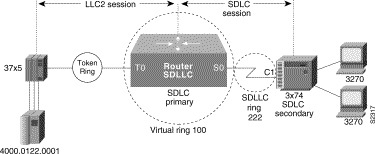
A configuration file that enables direct connection follows:
source-bridge ring-group 100 ! interface tokenring 0 source-bridge 111 1 100 ! interface serial 0 encapsulation sdlc-primary sdlc address c1 sdllc traddr 0110.2222.3300 222 2 100
sdllc partner 4000.0122.0001 c1 sdllc xid c1 1720001
Figure 29-10 shows a router configuration in which the router directly connects the Token Ring and the serial line but uses RSRB to create a virtual ring 100. This configuration has the following characteristics:
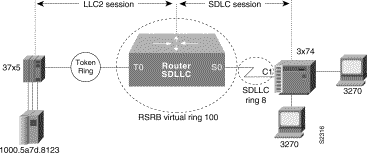
The following sample configuration file is for SDLLC with a single router using RSRB:
source-bridge ring-group 100 source-bridge remote-peer 100 tcp 131.108.1.1 source-bridge remote-peer 100 tcp 131.108.2.2 interface tokenring 0 ip address 131.108.2.2 255.255.255.0 source-bridge 111 1 100 interface serial 0 encapsulation sdlc-primary sdlc address c1 sdllc traddr 0110.2222.3300 8 1 100
sdllc partner 1000.5a7d.8123 c1 sdllc xid c1 17200c1
In Figure 29-11, SDLLC with RSRB connects an FEP and a single 3x74 cluster controller. The host wants to communicate with a single 3174 that its FEP sees on a Token Ring. However, the 3x74 seen by the FEP is in fact SDLC device C1 connected by means of a serial link through a remote router.
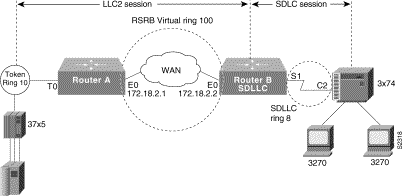
The configuration files for the network shown in Figure 29-11 follow.
source-bridge ring-group 100 source-bridge remote-peer 100 tcp 131.108.2.2 ! interface tokenring 0 ip address 131.108.1.1 255.255.255.0 source-bridge 10 1 100 ! interface ethernet 0 ip address 131.108.2.1 255.255.255.0
source-bridge ring-group 100 source-bridge remote-peer 100 tcp 131.108.1.1 source-bridge remote-peer 100 tcp 131.108.2.2 ! interface tokenring 0 ip address 131.108.2.2 255.255.255.0 source-bridge 1 1 100 ! interface serial 0 encapsulation sdlc-primary sdlc address c1 sdllc traddr 0110.2222.3300 8 1 100
sdllc partner 1000.5a7d.8123 c1 sdllc xid c1 17200c1
In the setup shown in Figure 29-12, Router A needs no SDLLC configuration, Router B has the SDLLC configuration and supports multipoint on the SDLC link with a modem-sharing device and Router C is also configured with SDLLC. For information about the NCP and VTAM system generation (sysgen) parameters that are used in this configuration see the "NCP and VTAM Sysgen Parameters" section later in this chapter.
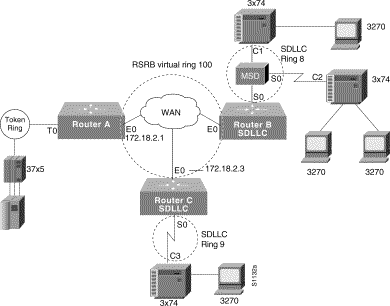
The following configuration files describe the network shown in Figure 29-12. The note references to the right of the configuration files refer to the "Notes" section at the end of this chapter.
source-bridge ring-group 100 source-bridge remote-peer 100 tcp 131.108.2.1 source-bridge remote-peer 100 tcp 131.108.2.2 source-bridge remote-peer 100 tcp 131.108.2.3 ! interface tokenring 0 ip address 131.108.1.1 255.255.255.0 source-bridge 10 1 100 ! interface ethernet 0 ip address 131.108.2.1 255.255.255.0
source-bridge ring-group 100 source-bridge remote-peer 100 tcp 11.108.2.1 source-bridge remote-peer 100 tcp 11.108.2.2 source-bridge remote-peer 100 tcp 11.108.2.3 ! interface ethernet 0 ip address 131.108.2.2 255.255.255.0 ! interface serial 0 encapsulation sdlc-primary sdlc address c1 sdlc address c2 sdllc traddr 0110.2222.3300 7 1 100 sdllc partner 1000.5a7d.8123 c1 sdllc partner 1000.5a7d.8123 c2 sdllc xid c1 17200c1 sdllc xid c2 17200c2
source-bridge ring-group 100 source-bridge remote-peer 100 tcp 131.108.2.1 source-bridge remote-peer 100 tcp 131.108.2.2 source-bridge remote-peer 100 tcp 131.108.2.3 ! interface ethernet 0 ip address 131.108.2.3 255.255.255.0 ! interface serial 0 encapsulation sdlc-primary sdlc address c3 sdllc traddr 0110.2222.3300 9 1 100 sdllc partner 1000.5a7d.8123 c3 MUST MATCH TIC LOCADD, NOTE 2
sdllc xid c3 17200c3 MUST MATCH VTAM IDBLK/IDNUM, NOTE 4
The configuration shown in Figure 29-13 enables local acknowledgment for Router B, which means that the LLC session terminates at Router A. However, the LLC2 session between Router A and Router C is not locally acknowledged and terminates at Router C.
For information about the NCP and VTAM system generation (sysgen) parameters that are used in this configuration see the "NCP and VTAM Sysgen Parameters" section later in this chapter.
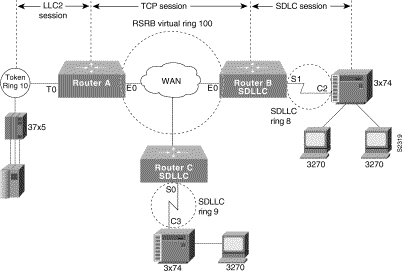
The following sample configuration files describe the network shown in Figure 29-13. (The notes in the sample configuration files refer to the "Notes" section at the end of this chapter.)
source-bridge ring-group 100 source-bridge remote-peer 100 tcp 131.108.2.1 source-bridge remote-peer 100 tcp 131.108.2.2 local-ack source-bridge remote-peer 100 tcp 131.108.2.3 ! interface tokenring 0 ip address 131.108.1.1 255.255.255.0 source-bridge 1 1 100 ! interface ethernet 0 ip address 131.108.2.1 255.255.255.0
source-bridge ring-group 100 source-bridge remote-peer 100 tcp 131.108.2.1 local-ack source-bridge remote-peer 100 tcp 131.108.2.2 source-bridge remote-peer 100 tcp 131.108.2.3 source-bridge sdllc local-ack ! interface ethernet 0 ip address 131.108.2.2 255.255.255.0 ! interface serial 0 encapsulation sdlc-primary sdlc address c1 sdllc traddr 4000.3174.0b0d 7 1 100 sdllc partner 1000.5a7d.8123 c1 !Must match TIC LOCADD [See NOTE 2] sdllc xid c1 017200c1 !Must match VTAM IDBLK/IDNUM [See NOTE 4] interface serial 1 encapsulation sdlc-primary sdlc address c2 sdllc traddr 0110.2222.3200 8 1 100 sdllc partner 1000.5a7d.8123 c2 !Must match TIC LOCADD [See NOTE 2] sdllc xid c2 017200c2 !Must match VTAM IDBLK/IDNUM [See NOTE 4]
source-bridge ring-group 100 source-bridge remote-peer 100 tcp 131.108.2.1 source-bridge remote-peer 100 tcp 131.108.2.2 source-bridge remote-peer 100 tcp 131.108.2.3 ! interface ethernet 0 ip address 131.108.2.3 255.255.255.0 ! interface serial 0 encapsulation sdlc-primary sdlc address c3 sdllc traddr 4000.3174.0c00 9 1 100 sdllc partner 1000.5a7d.8123 c3 Must match TIC LOCADD [See NOTE 2] sdllc xid c3 017200c3 !Must match VTAM IDBLK/IDNUM [See NOTE 4]
The following sections provide QLLC conversion configuration examples:
The examples describe four increasingly complex QLLC conversion topologies and possible router configurations for each. Following the examples are sample NCP definitions that the 37x5 FEP in these topologies could use and VTAM definitions that the IBM host in these topologies could use to reflect the routers in the communication path.
Figure 29-7, shown previously, illustrates the simplest QLLC conversion topology-a single 37x5 FEP on a Token Ring communicating with a single 3x74 cluster controller across an X.25 network. A router connects the Token Ring to the X.25 network. In Figure 29-7, notice that the router's X.25 interface is treated as a virtual ring for configuration purposes.
The following configuration file configures the router to support the network topology shown in Figure 29-7:
source-bridge ring-group 100 ! interface serial 0 encapsulation x25 x25 address 31102120100 x25 map qllc 0100.0000.0001 31104150101 qllc srb 0100.0000.0001 201 100 ! ! Allow the 3174 to initiate the connection. ! qllc partner 0100.0000.0001 4000.0101.0132 interface tokenring 0 source-bridge 100 1 201
In this configuration file, the source-bridge ring-group command defines a virtual ring number 100. The serial 0 interface that connects to the X.25 network is then configured for X.25 DTE operation using the encapsulation x25 command and assigned the X.121 address of 31102120100 using the x25 address command. The x25 map qllc command associates the X.121 address of the remote X.25 device (31104150101) with a virtual Token Ring MAC address (0100.0000.0001) the Token Ring device will use to communicate with this remote X.25 device. The qllc srb command indicates that the virtual MAC address of the X.25 device will be used to communicate with the real MAC address of the Token Ring device.
The qllc partner command enables the router to open a connection to the local Token Ring device at MAC address 4000.0101.0132 on behalf of the remote X.25 device at virtual Token Ring MAC address 0100.0000.0001. The source-bridge command configures the router's Token Ring 0 interface for local source-route bridging by associating the router's virtual ring number 100 with the ring number (1) of the local Token Ring and the bridge number (1) that uniquely identifies this bridge interface.
Figure 29-14 shows a slightly more complex QLLC conversion topology-the same 37x5 FEP on a Token Ring connects through a router to an X.25 network-but communicates with multiple 3x74 cluster controllers through X.25.
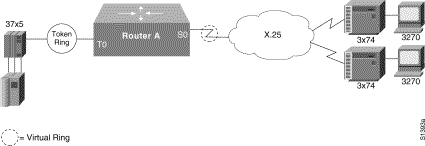
The following configuration file configures the router to support the network topology shown in Figure 29-14:
source-bridge ring-group 100 ! interface serial 0 encapsulation x25 x25 address 3137005469 ! ! configure the first 3174 ! x25 map qllc 0000.0cff.0001 31370054111 ! ! 1001 - virtual ring used by all qllc devices ! 100 - the virtual ring group ! qllc srb 0000.0cff.0001 1001 100 qllc partner 0000.0cff.0001 4000.1160.0000 qllc xid 0000.0cff.0001 01710017 ! ! configure the second 3174 ! x25 map qllc 0000.0cff.0002 313700543247 ! ! 1001 - virtual ring used by all qllc devices ! 100 - the virtual ring group ! qllc srb 0000.0cff.0002 1001 100 qllc partner 0000.0cff.0002 4000.1160.0000 qllc xid 0000.0cff.0002 01710017 ! interface Tokenring 0 ! ! Since this is a real bridge, we have to define the way it ! bridges to the Qllc virtual ring. ! source-bridge 1 1 100 source-bridge spanning
In the following example, two 3x74s on a Token Ring each attach to a different 37x5 on the other side of an X.25 network. Only one Token Ring interface is used. Do not create a bridge from the QLLC virtual ring (1001) to the physical Token Ring (1). Instead, define a virtual ring group (for example, 100).
interface serial 0 encapsulation x25 x25 address 3137005469 ! ! configure the router for the first 3x74 ! x25 map qllc 0000.0cff.0001 31370054111 ! ! 1001 - virtual ring used by all qllc devices ! 1 - the local Token Ring number ! qllc srb 0000.0cff.0001 1001 1 qllc partner 0000.0cff.0001 4000.1160.0000 ! ! configure the router for the second 3x74 ! x25 map qllc 0000.0cff.0002 31370053247 ! ! 1001 - virtual ring used by all qllc devices ! 1 - the local Token Ring number ! ! Note that the partner's MAC address and XID are different from ! those in the first 3x74. ! qllc srb 0000.0cff.0001 1002 1 qllc partner 0000.0cff.0002 4000.1161.1234 ! interface Tokenring 0 ! ! Since this is a real bridge, we have to define the way it bridges ! to the QLLC virtual ring. ! source-bridge 1 1 1001 source-bridge spanning
Figure 29-8, shown previously, includes an added arbitrary WAN in the communication path between the 37x5 FEP and the multiple 3x74 cluster controllers. The arbitrary WAN can be a multihop network, whereas QLLC conversion treats the X.25 network as a single-hop network.
In Figure 29-8, notice that the arbitrary WAN and the routers on either side of it form a single virtual ring, as configured using the source-bridge ring group global command.
In this configuration file, Router A uses an IP address of 131.108.2.2 and its Token Ring interface is attached to Token Ring 1. Because Router A connects to the Token Ring, it does not need to be configured for QLLC conversion. Router B, configured for QLLC conversion because it connects directly to the X.25 network through its serial interface, uses an X.121 address of 31102120100 and an IP address of 131.108.1.1. The 37x5 device uses a MAC address of 4000.0101.0132. The virtual MAC address of 0100.0000.0001 has been assigned to the 3x74 device.
The following configuration file configures the Router A in Figure 29-8:
source-bridge ring-group 100 source-bridge remote-peer 100 tcp 131.108.1.1 local-ack source-bridge remote-peer 100 tcp 131.108.2.2 local-ack ! interface ethernet 0 ip address 131.108.3.3 255.255.255.0 ! source-bridge 1 1 100 source-bridge spanning ! interface tokenring 0 ip address 131.108.2.2 255.255.255.0
The following configuration file configures the Router B in Figure 29-8:
source-bridge ring-group 100 source-bridge remote-peer 100 tcp 131.108.1.1 local-ack source-bridge remote-peer 100 tcp 131.108.2.2 local-ack source-bridge qllc-local-ack ! interface serial 0 encapsulation x25 x25 address 31102120100 x25 map qllc 0100.0000.0001 31104150101 x25 map qllc 0100.0000.0002 31104150102 qllc srb 0100.0000.0001 201 100 qllc srb 0100.0000.0002 201 100 ! ! Allow the 3174 to initiate the connection. ! qllc partner 0100.0000.0001 4000.0101.0132 qllc partner 0100.0000.0002 4000.0101.0132 ! interface ethernet 0 ip address 131.108.1.1 255.255.255.0
The sample system generation (sysgen) parameters in this section show typical NCP and VTAM values that correspond with the Router A, Router B, and Router C configurations shown in
Figure 29-12 and Figure 29-13 for SDLLC media translation and in Figure 29-8 for QLLC conversion.
IBM's ACF/NCP uses a function called NTRI (NCP/Token Ring Interconnection) to support Token Ring-attached SNA devices. NTRI also provides translation from Token Ring-attached SNA devices (Physical Units) to switched (dial-up) devices. VTAM provides the resolution for these devices in a Switched Major Node. VTAM treats these devices on NTRI logical lines as switched devices. (For more information consult IBM documentation NCP/SSP/EP Resource Definition Reference, SC30-3448-04.)
Using SDLLC, the Cisco router translates SDLC leased line protocol into Token Ring LLC2 protocol, then the NTRI function in ACF/NCP translates Token Ring LLC2 protocol into an SNA switched protocol.
***************************************************************** *** SAMPLES BASED ON ACF/NCP V5 R4. *** NOT ALL NCP PARAMETERS ARE SHOWN ***************************************************************** * ***************************************************************** * OPTIONS DEFINITION STATEMENT ***************************************************************** NCPOPT OPTIONS NEWDEFN=YES NTRI GENERATION, MUST BE FIRST STMT * ***************************************************************** * BUILD MACRO ***************************************************************** NCPBU BUILD LOCALTO=1.5, NTRI ACK TIMER FOR LOCAL TOKEN RINGS REMOTTO=2.5, NTRI ACK TIMER FOR REMOTE TOKEN RINGS USED IN SDLLC CONFIGURATIONS, NOTE 1 * ***************************************************************** * DYNAMIC RECONFIGURATION POOL SPACE ***************************************************************** DRPOOL LUDRPOOL NUMTYP2=50 RESERVE 50 LUS ON PU. T2 PUS * ***************************************************************** * PHYSICAL GROUP FOR NTRI TIC #1, DEFINITIONS FOR THE TOKEN RING * ADAPTER TO ESTABLISH PHYSICAL CONNECTIVITY ***************************************************************** EPHYG GROUP ECLTYPE=PHYSICAL * EPHYL LINE ADAPTER=TIC2, TYPE OF ADAPTER ADDRESS=(16,FULL), INTERNAL FEP TIC ADDRESS PORTADD=0, LOCADD=10005a7d8123, TIC ADDRESS, NOTE 2
RCVBUFC=1440, MAXTSL=2012, TRSPEED=16 TOKEN RING SPEED * EPHYPU PU * EPHYLU LU ISTATUS=INACTIVE * ***************************************************************** * NTRI PERIPHERAL LOGICAL LINE GROUP, LINE AND PU PAIRS ARE * GENERATED BY THE AUTOGEN PARAMETER. ***************************************************************** ELOGG GROUP ECLTYPE=LOGICAL, PHYPORT=0, CALL=INOUT, AUTOGEN=3 ONE PER SDLLC CONTROLLER, NOTE 3
*****************************************************************
***************************************************************** * VTAM SWITCHED MAJOR NODE, BASED ON ACF/VTAM V3 R4. * THE CODING BELOW SUPPORTS DIAL IN OPERATION ONLY. TYPICALLY, * NTRI IMPLEMENTATIONS USE ONLY DIAL IN. IF DIAL OUT FROM AN * APPLICATION IS REQUIRED, PATH MACROS MUST BE USED. CONSULT * THE APPROPRIATE VTAM INSTALLATION REFERENCE MANUAL. ***************************************************************** VSWITCH VBUILD TYPE=SWNET * VPU1 PU ADDR=13, COULD BE ANYTHING (NOT USED) IDBLK=017, XID PARM, NOTE 4
IDNUM=200c1, XID PARM, NOTE 4
MAXOUT=7, MAXDATA=265, MODETAB=AMODETAB, DLOGMOD=US327X, PUTYPE=2, USSTAB=USS327X * VLU1A LU LOCADDR=2, VLU1B LU LOCADDR=3 * VPU2 PU ADDR=13, COULD BE ANYTHING (NOT USED) IDBLK=017, XID PARM, NOTE 4
IDNUM=200c2, XID PARM, NOTE 4
MAXOUT=7, MAXDATA=265, MODETAB=AMODETAB, DLOGMOD=US327X, PUTYPE=2, USSTAB=USS327X * VLU2A LU LOCADDR=2, VLU2B LU LOCADDR=3 * VPU3 PU ADDR=13, COULD BE ANYTHING (NOT USED) IDBLK=017, XID PARM, NOTE 4
IDNUM=200c3, XID PARM, NOTE 4
MAXOUT=7, MAXDATA=265, MODETAB=AMODETAB, DLOGMOD=US327X, PUTYPE=2, USSTAB=USS327X * VLU3A LU LOCADDR=2, VLU3B LU LOCADDR=3 *
In these sample definitions:
1 . REMOTTO is the NCP's T1 timer for remote Token Rings. All connections use RIF information and therefore look like remote Token Ring devices. The default is 2.5 seconds, which is adequate for most situations; however, when slow-speed links are used, this parameter should be reviewed to ensure enough time for link-level acknowledgments.
2 . The LOCADD parameter defines the locally administered address of the TIC in the NCP. The Cisco routers, configured for SDLLC, will insert this address as the 802.5 destination address field in TEST and XID frames to establish connectivity and then in data frames during the session. The sdllc partner and qllc partner commands define this connection in the Cisco routers. Each SDLC control unit is defined with an sdllc partner or qllc partner command.
3 . The AUTOGEN parameter specifies the number of LINE and PU pairs that are automatically generated by NDF (Network Definition Facility). Each controller requires a LINE and PU definition in the ELCTYPE LOGICAL group. These represent control block space in the NCP simulating switched line as described earlier.
4 . The IDBLK and IDNUM parameters in VTAM are used to identify incoming connection requests. IDBLK is typically unique for each type of IBM device. IDNUM is any five hexidecimal digit combination. The Cisco routers configured for SDLLC or QLLC conversion must associate an IDBLK/IDNUM combination with a controller by using the sdllc xid or qllc xid command. If not using the qllc xid command, then IDBLK/IDNUM must agree with the values of the X.25 attached devices. During activation, an XID will be sent to the NCP containing the specific IDBLK/IDNUM. NCP will send these values to VTAM in an SNA command called REQCONT. VTAM will search its switched major nodes to find a match. If found, VTAM will establish sessions with the device by sending activation commands (ACTPU, ACTLUs).
|
|